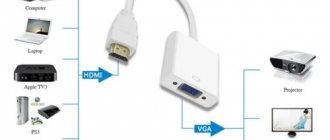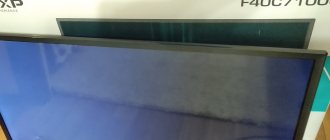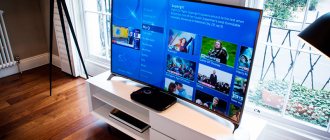TVs with a screen diagonal of over 42 inches are in unprecedented demand in the market. The phenomenon is due to the fact that about 75% of consumers believe that the larger the display, the better the image it reproduces. The statement is not entirely correct, since the clarity, naturalness of colors and good sharpness of the image depend on the resolution of the TV monitor. The viewing distance and the characteristics of the incoming signal are also important. Let's find out what is the best TV screen resolution to choose, based on its purpose and operating conditions. At the same time, let’s define the existing types of screens.
If the image does not fit
To deal with this problem, you need to turn off the Overscan option on your television receiver.
If this is a computer, then after updating the video card drivers, you need to right-click on the desktop. If you have a GeForce video card, then go to the NVIDIA program settings. If you have a Radeon video card, then go to the Catalyst Control Center program. Then adjust the parameters using the slider in the “desktop” settings to the required value.
Changing the picture format on a TV set-top box
If the TV is powered by a set-top box, it is possible to change the picture parameters using its functions. Usually you need to open the menu, go to the “Settings” section, where select the “Display” tab. In this menu you can change the following parameters:
- image resolution (screen resolution);
- picture position (screen position);
- screen rotation;
- switching HDR mode.
The list of options may also vary depending on the model and manufacturer of the set-top box. Some series of set-top boxes do not allow you to customize frame parameters at all, using only the parameters specified in the TV itself.
In the first part of the review (https://ammo1.livejournal.com/231535.html) I talked about the image quality, in the second part (https://ammo1.livejournal.com/232622.html) about the design, remote control and Ambilight function , in the third part (https://ammo1.livejournal.com/233666.html) about 3D, USB player, DLNA player and NetTV. In this part I will talk about controlling the TV.
I wrote about the remote control in the second part. In addition to the remote control, the TV can be controlled using an iPhone.
The TV turn on time is 13 seconds.
The analog channel switching time is exactly 1 second. Many TVs change channels much more slowly: https://ammo1.livejournal.com/82118.html. Channels can be scrolled through by quickly pressing the channel change buttons. For example, to move from the first channel to the fifth, you do not have to wait for each channel image to appear after each press of Ch+. You can quickly press Ch+ five times and immediately get to the fifth channel. The switching time for DVB-T digital channels is 4.4 seconds. On my Panasonic this time is just as long, so the problem is apparently in the DVB standard itself.
It is very convenient that analog and digital channels are included in one list (for example, channels 1-8 are digital, and 9-50 are analog). On most TVs, the analog and digital tuner need to be switched in the same way as external sources.
Channels can be switched sequentially, you can enter the channel number (three characters are entered. If you enter one or two characters, you need to press OK or wait), you can select channels through the list using the Find button.
External inputs are selected in one of two ways. You can click Source and select an input.
You can assign an input to some external device (for example, “Blu-ray” or “Computer”) and place a shortcut in the main menu, called up by the “home” button.
Checking digital television support on DEXP TV
Before you begin the process of setting up digital TV channels, make sure that the TV receives digital terrestrial television in principle. The fact is that this opportunity is provided only for models that comply with the European broadcasting standard DTV-T2.
DTV-T2 implements broadcasting of digital terrestrial TV on the territory of the Russian Federation.
To make sure your TV supports this standard, refer to the instructions that came with your TV. Typically, such information is indicated at the very beginning, since the presence of a digital broadcast reception function is one of the main parameters regarding the functionality of any television.
Electricity consumption
All six MX TVs are rated Class A energy efficient
- the highest energy efficiency class, according to the new EU directives, which came into force in January 2021 (previously there were 10 classes, from A+++ to G; now there are 7, from A to G). This means that TVs operate 70% more efficiently than EU standards allow (EEIl coefficient
At the same time, the energy consumption of the models is different and depends, logically, on the screen size. For example, the model with the maximum screen diagonal Haier 65 Smart TV MX consumes 170 Wh, the model with the minimum diagonal Haier 32 Smart TV MX - 56 Wh. Power consumption in standby mode for all is no more than 0.5 Wh.
According to research company Mediascope, in 2021, Russians watched TV for an average of 3 hours and 40 minutes a day. To estimate electricity consumption, let’s round up to 4 hours:
How to change resolution to Full HD
Below we will tell you how to change the resolution to Full HD for each individual desktop, as well as for all Windows 10 users.
On a note! Sometimes an attempt to change the picture display quality can result in the tiles of applications attached to the start menu being empty. If this happens to you, then restarting File Explorer should help.
In general, the entire operation of changing the screen resolution comes down to the following steps:
Step 1. To open the display settings, follow steps 1, 2 or 3:
Step 2: If you have multiple displays installed on your PC, select the one from the list (example: “2”) whose resolution you want to change (see screenshot below).
Note! If all your displays are not visible, click on the "Detect" button. So Windows will try to find them.
Step 3. If you are not sure what number a certain display has, click on the “Detect” button (in the screenshot below). This will cause the system to briefly display the number of each display. However, this feature only appears when connecting multiple monitors.
Step 4: Follow Step 5 (Recommended) or Step 6 (Custom) to change the screen resolution of the selected display.
Step 5. Select screen resolution 1920x1080 or Full HD.
Step 6. Select display mode and screen resolution (custom).
Menu for setting up the general interface (ci)
Page 38
- Image
- Text
36
Menu for setting COMMON INTERFACE (CI)
Smart card
CA module
General interface
Common Interface (CI) Slot is designed for installing a conditional access (CA) module along with a smart card to view TV programs provided by Pay TV service providers. For more information about modules and subscription options, contact your CI representative. CI and smart cards are not included with the TV manufacturer.
ATTENTION:
Turn off the TV before inserting any module or smart card into the TV.
No image, show text version
What if the TV does not support digital TV?
If your TV model still does not have its own internal factory tuner, but you are not ready to purchase a new TV, buy a special set-top box for broadcasting television for free.
It is better if you purchase a set-top box specifically for the DEXP TV. Prices vary from approximately 1000 to 1500 rubles.
The manufacturer offers quite a few options, from those that have the standard you need, for example:
After purchase, the set-top box will need to be connected and configured. The set-top box always comes with detailed instructions and step-by-step diagrams, with the help of which its purpose can be realized without unnecessary problems.
FullHD or HD Ready
On the packaging boxes of TVs, in addition to the FullHD inscriptions, you often find other inscriptions - HD Ready.
In 2005, the European Association of Telecommunications Technologies and Information Systems adopted standards for new TV models that will display video with high quality parameters. They are divided into two categories: HD Ready and FullHD.
HD Ready supports the minimum resolution for this class - 720 lines, and FullHD, where the screen resolution is 1920x1080, is capable of handling video with 1080 lines.
This name was picked up by the Japanese company when in 2007 it named a number of its products as the FullHD brand. Other companies in this market segment began to call their products the same way.
Therefore, most of the FullHD-class liquid crystal and plasma television receivers sold nowadays (translated from English as “full screen resolution 1920×1080″) have a screen aspect ratio of 16 by 9 and support videos with 1080 lines of image. Such images compare favorably with the quality of a simple DVD; they are clearer and of higher quality.
So what is screen resolution, how do screen settings affect the picture we see on the monitor?
The TV screen, whatever it may be, plasma or liquid crystal, is a matrix that consists of pixels located horizontally and vertically of the screen. Their number is called matrix resolution. Screen resolution comes in many types, but the most famous are 1024x768, 1366x768, and many others.
Processor, memory and wireless connection
The MX series TVs have a quad-core processor based on ARM Cortex-A55
with a frequency of 1.4 GHz (DynamIQ architecture) and an
ARM Mali-470
(with support for the OpenGL ES 2.0 driver package).
Random access memory (RAM) - 1.5GB DDR3 standard. Built-in (ROM) - 8GB. microSD memory cards
and
USB-Flash 2.0
. From a flash drive, which has two connectors, you can watch videos or photos and listen to music in a pre-installed media player (supports MPEG2, MPEG4, H.265 codecs).
The wireless connection protocols in Haier TVs are the same for the entire model range of the company (not just the MX series): Bluetooth 5.0
and
Wi-Fi
, which can distribute signals at 2.4 and
5 GHz
. The Internet can also be connected via an optical cable (Ethernet).
TV Philips 42PFL7606. Part 4. Management.
The Xbox One console supports different display options. Choose the best settings for your TV by following these steps. The Xbox One console supports the following resolutions. These resolutions are standard for HDTV:. The refresh rate indicates how many times per second the TV or monitor screen displays an image. The refresh rate is usually measured in Hertz cycles per second. The display, which outputs images 60 times per second, has a 60Hz refresh rate, which is the default refresh rate for all Xbox One consoles.
TV as a monitor
Forgot your password? Posted January 24, Good afternoon. I recently connected to Onlime and just yesterday purchased a Philips 42″ TV, the problem arose immediately.
Channels are not displayed in full screen. I tried various TV settings, but I managed to stretch the picture to the maximum in height, but it does not stretch in width. HD channels are shown with a bang. Plus, if you connect the coaxial cable wire directly to the TV, then all the channels are stretched as they should. Kind people tell me how to deal with this problem. If the task is to stretch the image in width and we understand that the proportions will be violated - all people will have wide faces, then try selecting a 4x3 screen in the settings of the receiver.
This is an old problem - broadcasting on some channels is in the format, others And, it seems, Philips has an auto-format detection mode, but Personally, I looked at how the show is shown on a channel with the format, either with a height cut ala, or full, and the TV jumps switching resolution, adjusting the image back and forth. Maybe that’s why I didn’t buy Filya, but bought Sharp.
Haier Android TV operating system
All Smart TVs MX come pre-installed with Haier Android TV version 9.0 (Android Pie, latest update released in 2021). Its advantages:
- Supports voice search and Google Assistant.
- Built-in browser for Internet surfing.
- Large selection of applications in the Google Play Store.
- Supports YouTube, Google Play Movies, Google Music and Google Games.
- Google Chromecast
support . The technology allows you to broadcast content from a tablet, mobile phone or laptop to a TV screen wirelessly (you only need a Wi-Fi connection). - The pre-installed Haier EVO TV application, which saves time, tells you about the latest in online cinemas and helps you search for movies on partner platforms, including Megogo, Ӧkko, Start and Kinopoisk HD.
- Regular operating system updates.
How to make the resolution 1920x1080
Screen resolution determines how much information is shown on the display. It is measured horizontally and vertically in pixels. At lower settings, such as 640x480, fewer elements will appear on the screen, but they will be larger. When the resolution is 1920x1080, the monitor displays more elements, but they are smaller in size. The resolution modes for each display are different and depend on the video card, monitor size and video driver.
On a note! Windows 10 comes with integrated support for 4K and 8K displays.
By default, the system selects the best display settings for your computer based on its monitor.
If you wish, you can manually change the screen resolution to Full HD for each desktop.
Video - How to make the resolution 1920x1080
Possible TV malfunctions and their elimination
Although the pixel count and quality of TV panels have continued to increase over the years, flat screen TVs have still traditionally suffered from poor sound. Decent speakers need room to work their magic, and a regular LCD or OLED TV simply doesn't have the space to do them justice. With Philips TV, the company brings the same quality of sound to a 4K LCD display with impressive results. Philips hasn't yet set a release date for Philips, but we're told they're expecting a release by May of the year, with pricing to be announced around the same time. With screen sizes of 50, 55 and 65 inches, Philips is able to create an attractive design despite the added pressure or need to find space for a soundbar located under the screen. You'll see it sits on two clear legs towards either end of the screen, giving the panel the appearance of floating when mounted on an AV case, and allowing its 3-sided Ambilight lighting array on the back to allow on-screen colors to bloom behind the display. reflect the hues happening around them. A thin bezel sits around the edge of the screen, but it's the soundbar that really grabs the attention.
Why you should trust professionals
If a narrow TV screen appears when you turn it on, we recommend not to take risks, but to seek help from qualified service staff. Modern TVs are filled with electronics. Illiterate intervention in the operation of complex systems can lead to serious breakdowns with irreversible consequences. Our company’s specialists perform work at a professional level; they have the necessary spare parts, precision tools, and special equipment at their disposal.
Work order:
- the technician conducts a thorough diagnostics of the unit;
- finds the location of the breakdown;
- determines the degree of complexity of the repair;
- draws up an action plan;
- selects the necessary parts for replacement (new parts are covered by a manufacturer’s warranty);
- troubleshoots.
At the final stage, a test viewing of all TV channels is done, and the settings are adjusted if necessary. Contact Remontano, call by phone, leave applications on the website.
Where did 2K, 4K, 8K come from?
There are more than 30 different resolution formats, ranging from QVGA 240x320 px to a stunning 10K with a resolution of 10240x5760 px. You can study the most common screen resolutions below.
| Name | Permission | Aspect Ratio |
| HDTV (Full HD) (FHD) 1080p | 1920×1080 | 16:9 |
| WUXGA | 1920×1200 | 16:10 |
| 2K DCI (Cinema 2K) | 2048×1080 | 19:10 |
| QWXGA | 2048×1152 | 16:9 |
| QXGA | 2048×1536 | 4:3 |
| UWHD | 2560×1080 | 64:27 |
| WQXGA (WQHD) (QHD 2K) | 2560×1440 | 16:9 |
| WQXGA | 2560×1600 | 16:10 |
| QSXGA | 2560×2048 | 5:4 |
| WQXGA+ | 3200×1800 | 16:9 |
| WQSXGA | 3200×2048 | 25:16 |
| QUXGA | 3200×2400 | 4:3 |
| Ultra WQHD | 3440×1440 | 21:9 |
| 4K UHD (Ultra HD) | 3840×2160 | 16:9 |
| WQUXGA | 3840×2400 | 16:10 |
| 4K DCI (Cinema 4K) | 4096×2160 | 19:10 |
| 5K/UHD+ | 5120×2880 | 16:9 |
| HSXGA | 5120×4096 | 5:4 |
| WHSXGA | 6400 × 4096 | 25:16 |
| HUGA | 6400 × 4800 | 4:3 |
| 8K UHD (UHDTV-2X) | 7680 × 4320 | 16:9 |
| WHUXGA | 7680 × 4800 | 16:10 |
| 10K | 10240 × 5760 | 16:9 |
| 12K | 11520 × 6480 | 16:9 |
Attentive readers will have noticed that there are a couple of different lines in the table with 2K designations. The situation is similar with 4K resolution. In fact, there are several different resolutions for the 4K format:
| Academic 4K | 3656 × 2664 | 1,37:1 |
| Casketed 4K | 3996 × 2160 | 1.85:1 (Flat) |
| Full frame 4K | 4096 × 3072 | 1,33:1 (4:3, 12:9) |
| Widescreen 4K | 4096 × 1716 | 2.39:1 (Scope) |
| DCI 4K | 4096 x 2160 | 1,89:1 (256:135) |
| Ultra HD 4K | 3840 × 2160 | 1,78:1 (16:9) |
Horizontally, almost all of them are close to four thousand pixels, but the vertical resolution directly depends on the aspect ratio. True 4K in this case is called DCI 4K, used in cinema. However, the aspect ratio of this format was not suitable for monitors and televisions. That is why the Consumer Electronics Association (CEA) in 2012 approved a single 4K format for digital electronics, which was called Ultra HD 4K.
This means that if 4K is indicated on the box of a monitor or TV, then according to the accepted specification it will have a resolution of exactly 3840x2160.
The situation is similar with 2K - DCI 2K 2048x1080 is considered true, but among monitors and TVs, 2K is understood as UWHD (2560x1080) or QHD (2560x1440) formats.
By analogy with the already established 2K and 4K, the 8K format corresponds to a resolution of 7680 × 4320 pixels.
Screen resolution 1920×1080. Screen Settings
In the modern world, everything is changing rapidly.
Cameras of all models, from the cheapest point-and-shoot cameras to professional DSLRs, can shoot HD quality videos. This video is also possible for expensive mobile phone models. DVD video standards are a thing of the past. Film studios are making new spectacular films with previously unavailable effects. The requirements for video and television equipment standards are also growing. Viewers want movies that are shot in higher quality images—they want to view them on wide screens, not just on a computer monitor.
How to adjust resolution
First you need to disable EDID.
Then set the resolution to 1920x1080 in the screen properties.
Reinstall the video card driver (remove the old driver).
If the previous measures did not help, try reinstalling Windows.
I would like to hope that after this information, questions about how to set the screen resolution to 1920x1080 will be easier to resolve.
Source
Useful tips
Settings vary, but there are other factors to consider:
- TV location. Placing the TV in front of or next to a window is not a good idea. Light will hit the screen and create glare, which will reduce the overall picture quality;
- The optimal placement of the TV panel is when 70% of the display is located below the eye line;
- You cannot place the TV close to the wall. The equipment heats up during operation, so it needs at least 10 cm of free space for air circulation;
- To achieve the highest quality picture, you should use the HDMI interface, designed for transmitting high-definition multimedia.
Adjusting the picture on an LG TV is not as difficult as it seems. Fortunately, new TVs have many parameters and technologies that can be adjusted “to suit you.” It’s also worth understanding one thing - the model with the brightest screen (if compared in a store) is not necessarily the best. This is a race of manufacturers, where everyone wants to stand out by providing a “rich, bright and detailed picture.”
Similar articles
Methods for connecting the Dandy console to a modern TV
HDMI Versions
HDR10 and Dolby Vision - what is it and what is better
Deciphering Samsung TV markings with examples
Progressive and interlace scanning
To save space on air, a scan was invented that reduces the frame rate by half. It was called interlaced. First, the first half of the frame is transmitted in odd lines, then the second half in even lines. Interlaced scanning would look blurry if there was no way to restore image quality.
In order to explain the method that forms the image, after the number of lines the initial English is written: “p” or “i”. For example: a resolution of 1920 x 1080p indicates that the picture was generated in a progressive way. And the 720i marking will mean that the video has 720 lines. And the letter i stands for the interlaced method. In order to indicate the format, the second-by-second frame size is indicated. When they say 1080p30, this means that there are thirty frames in this video, running per second. The higher the number of frames, the better and more detailed the picture looks.
Basic image parameters
Every manufacturer is interested in having a hardware store visitor buy its TV. For this purpose, the basic picture settings are set in such a way that it looks as rich as possible (especially in stores with good lighting). But, having bought a TV and installed it at home, it turns out that the image is not so colorful, so you have to adjust it further.
To set it up correctly, you need a little time and a remote control with a “” or “Settings” button. To adjust the basic parameters, go to the “Image” section.
Intensity
This term refers to color saturation. One of the common mistakes when setting up occurs when the user wants “as many colors as possible” and turns the intensity to maximum. Yes, the picture turns out juicy, but unnatural, which is why your eyes will quickly get tired.
To ensure the screen produces optimal colors, this parameter is set to medium values. For ease of adjustment, it is recommended to select a test image with relatively desaturated colors, for example, a natural landscape.
Brightness
This term is the balance of black in relation to the entire palette. To put it simply, the parameter determines the quality of display of dark areas. On many TVs, including LG, the brightness is set to extremely high, so most users are accustomed to thinking that brighter is better. In fact, this is not the case. If you adjust the brightness too high, blacks become gray, reducing picture clarity.
If you set the brightness to low, dark pixels become more visible, but it is more difficult to distinguish similar shades of black. This parameter must be configured in the room where the TV will be installed. The level of illumination is also taken into account. As a rule, people watch TV early in the morning or in the evening, after work, that is, in the dark. Therefore, adjustments are carried out in low light conditions.
You can find the optimal brightness by eye. To do this, they turn on the film and, when there is a picture with textured black and shadows on the screen, they pause it. As you decrease the brightness, the blacks will become more intense and the shadows will appear darker.
The optimal setting is when black is perceived as truly black and not gray (high value). At low brightness, dark areas appear less detailed.
Contrast
This setting is the opposite of brightness. It determines the white level, how intense the light parts of the image will be. The goal of the adjustment is to achieve a bright picture in which individual details are clearly visible.
The easiest way to check contrast is in scenes with clouds - set it to maximum and gradually lower it until details are visible instead of white spots.
On many LCD monitors, the contrast level is set to 80 - 90%. It’s better to reduce it to 65% and dance from this mark. In the case of plasma TV, it is recommended to set lower values to avoid panel burnout.
Adjusting the contrast on your TV.
How to connect a TV to a computer via HDMI
If the image size is smaller than the TV screen, black bars may appear on the screen. If the image size is wider than the TV screen, the aspect ratio on the screen may change and the image may be distorted. How to find out the series and year of production of a TV. The size of the picture depends on the source from which the image comes. The table shows a list of sources and available sizes. We would be grateful if you look at other articles or share this one. Give us another chance - contact our support team.
Checking for digital TV support on DEXP
Before proceeding directly to the setup, let’s make sure that your equipment supports digital terrestrial TV reception. This function is only available on models that support the DVB-T2 broadcast standard.
To check for DTV support, enter your TV model number in the Search box in the table below. If it is found, feel free to start setting it up - your receiver can pick up “digital” without additional attachments.
| Model | Diagonal | DVB-T2 support |
| 22A7100 | 22 | + |
| 22A7200 | 22 | + |
| 24A7100 | 24 | + |
| 28A3000 | 28 | + |
| 32A3000 | 32 | + |
| 32A3100 | 32 | + |
| 32A3200 | 32 | + |
| 32A7000 | 32 | + |
| 40A7000 | 40 | + |
| 40A7100 | 40 | + |
| 42A7000 | 42 | + |
| 42A8000 | 42 | + |
| 42A8100 | 42 | + |
| 42A8200 | 42 | + |
| 42A9000 | 42 | + |
| 46A7000 | 46 | + |
| 49A8200 | 49 | + |
| 50A7000 | 50 | + |
| 50A7100 | 50 | + |
| 50A8000 | 50 | + |
| 55A8000 | 55 | + |
| F22B7000C | 22 | + |
| F22B7000E/B | 22 | + |
| F22B7000E/W | 22 | + |
| F22B7100EE | 22 | + |
| F22B7200C | 22 | + |
| F22D7100E | 21.5 | + |
| F24B7000C | 24 | + |
| F24B7000E | 24 | + |
| F24B7100EE | 24 | + |
| F24B7100K | 24 | + |
| F24B7200C | 24 | + |
| F24B7200VE | 24 | + |
| F24D7100E | 23.6 | + |
| F24D7200C | 23.6 | + |
| F32C7000B | 32 | + |
| F32C7100B | 32 | + |
| F32C7100B/W | 32 | + |
| F32D7000B | 32 | + |
| F32D7000C | 32 | + |
| F32D7000C/W | 32 | + |
| F39B7000VD | 39 | + |
| F39B7100E | 39 | + |
| F40B7000C | 40 | + |
| F40B7000E | 40 | + |
| F40B7000H | 40 | + |
| F40B7000K | 40 | + |
| F40B7100K | 40 | + |
| F40B7200C | 40 | + |
| F40B8300K | 40 | + |
| F40C7100C | 40 | + |
| F40C7100K | 40 | + |
| F40C8000H | 40 | + |
| F40D7100C | 39.6 | + |
| F40D7200C | 40 | + |
| F40D7200C/W | 40 | + |
| F42B7000ED | 42 | + |
| F42B7000M | 42 | + |
| F42B7000T | 42 | + |
| F42B8000H | 42 | + |
| F42B8100K | 42 | + |
| F42C7000E | 42 | + |
| F43B7200С | 43 | + |
| F43B7200S | 43 | + |
| F43B8000H | 43 | + |
| F43B8000K | 43 | + |
| F43C7000C | 43 | + |
| F43C7100K | 43 | + |
| F43C8000H | 43 | + |
| F43D7000K | 43 | + |
| F43D8000K | 42.5 | + |
| F43D8100H | 43 | + |
| F46B7000MD | 46 | + |
| F48B7000M | 48 | + |
| F48B7000V | 48 | + |
| F48C7200K | 48 | + |
| F48D7000K | 48 | + |
| F48D8000K | 47.6 | + |
| F49B7000T | 49 | + |
| F49B7200C | 49 | + |
| F49B8000K | 49 | + |
| F49B8100K | 49 | + |
| F49B8200K | 49 | + |
| F49C7000C | 49 | + |
| F49C8000H | 49 | + |
| F49D8100H | 48.5 | + |
| F50B8000H | 50 | + |
| F55B7000T | 55 | + |
| F55B7200C | 55 | + |
| F55B8000H | 55 | + |
| F55B8000K | 55 | + |
| F55B8100K | 55 | + |
| F55B8200K | 55 | + |
| F55C7000C | 55 | + |
| F55C8000H | 55 | + |
| F55D7000E | 54.6 | + |
| F55D7000K | 54.6 | + |
| F55D8000K | 54.6 | + |
| h29B7000С | 19 | + |
| h29B7000E | 19 | + |
| h29D7100E | 19 | + |
| H20B7200C | 20 | + |
| H20C7200C | 20 | + |
| H20C7200C/W | 20 | + |
| H20D7000E | 19.5 | + |
| H24B3000EE | 24 | + |
| H24B7000E | 24 | + |
| H24B7100 | 24 | + |
| H24C3000E | 24 | + |
| H24C7200C | 24 | + |
| H24D7000E | 23.6 | + |
| H28B7100C | 28 | + |
| H28B7100E | 28 | + |
| H28C7100C | 28 | + |
| H28D7200K | 28 | + |
| H28D7300K | 28 | + |
| H32С8000H | 32 | + |
| H32B3200CD | 32 | + |
| H32B3400ED/A | 32 | + |
| H32B7000C | 32 | + |
| H32B7100K | 32 | + |
| H32B7200C | 32 | + |
| H32B7200T | 32 | + |
| H32B7300C | 32 | + |
| H32B7400C | 32 | + |
| H32B8200K | 32 | + |
| H32C7100C | 32 | + |
| H32C7200K | 32 | + |
| H32C7300K | 32 | + |
| H32D7000E | 32 | + |
| H32D7000M | 31.5 | + |
| H32D7000Q | 31.5 | + |
| H32D7100C | 32 | + |
| H32D7100K/W | 32 | + |
| H32D8000Q | 31.5 | + |
| H32D8100H | 32 | + |
| H39D7000E | 39 | + |
| H39D7000Q | 38.5 | + |
| H39D7100E | 39 | + |
| H39D8000Q | 39 | + |
| U40B9000H | 40 | + |
| U42B9000K | 42 | + |
| U43D9100H | 42.5 | + |
| U43D9100K | 42.5 | + |
| U49B9000K | 49 | + |
| U49D9000K | 48.5 | + |
| U50B9000H | 50 | + |
| U55B9000H | 55 | + |
| U55B9000K | 55 | + |
| U55B9100K | 55 | + |
| U55D7100E | 54.6 | + |
| U55D9000K | 54.6 | + |
| U58B9900H | 58 | + |
| U65D9000K | 64.5 | + |











